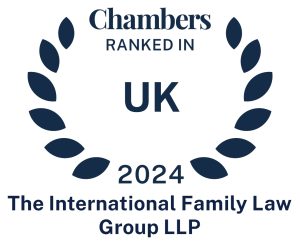Hague Convention of 19 October 1996 on Jurisdiction, Applicable Law, Recognition, Enforcement and Co-operation in Respect of Parental Responsibility and Measures for the Protection of Child.
The Hague Convention on Jurisdiction, Applicable Law, Recognition, Enforcement and Co-operation in Respect of Parental Responsibility and Measures for the Protection of Child was concluded on 19 October 1996 “The 1996 Convention” and entered into force in the UK in November 2012.
The overall aim of the 1996 Convention is to improve the protection of children in international situations and to establish cooperation between the authorities of the contracting states to achieve this aim.
The aims of the 1996 Convention are set out in Article 1
The key rule is to give jurisdiction to take protective measures to the authorities of the child’s country of habitual residence using its domestic laws. It also allows authorities of other states to take emergency measures when the child is present in that country at the request of the state with habitual residence or with it’s agreement. The 1996 Convention also takes into account of children with no habitual residence such as refugee children.
In contrast to the 1980 Hague Convention (which applies to child under 16) the 1996 Convention applies to children under the age of 18. As a consequence it can be used to extend the operation of the 1980 Hague Convention to pursue the return of children over 16. In short, the 1996 Convention seeks to address situations such as protection of children at risk and administration of children’s property across borders, protection of refugee or internationally displaced children, trafficked children, runaway teenagers and unaccompanied minors, cross border parental disputes over custody or access, including access applications not fully addressed by the 1980 Convention, conflicting claims for parental responsibility across borders, placement of children in foster or institutional care overseas; and international parental child abduction matters outside the 1980 Hague Convention.
The 1996 Convention contains seven chapters
- Chapter I deals with the scope of the Convention, the objectives of it and giving guidance
- Chapter II deals with jurisdiction, the jurisdictional rules are based essentially on the child’s Habitual Residence, although Habitual Residence is not defined
- Chapter III deals with applicable law and the general principle is that the state/authority with jurisdiction shall apply its own domestic law
- Chapter IV deals with recognition and enforcement and provides the general principle that protection measures taken in one state should be recognised in all states
- Chapter V deals with cooperation between contracting states, this is done in practice through the contracting states Central Authorities and this chapter deals with the exchange of information between them
- Chapter VI sets out general provisions, provision for inter-play between this convention and other conventions such as 1980 Hague Convention, issuing of international certificates of Parental Responsibility
- Chapter VII provides normal final clauses such as dealing with rights to ratify and accede
There are a number of key provisions/articles of the 1996 Convention that are worth highlighting
- Article 2 sets out that the 1996 Convention applies from the moment of birth until a child reaches the age of 18, this is a major difference to the 1980 Convention as referred to above
- Article 3 sets out the types of matters covered by the 1996 Convention but they are not exhaustively defined. The article sets out that the 1996 Convention covers matters such as: parental responsibility and how it is obtained, exercised and terminated, rights of custody and access (this is similar to the definition contained in Article 5 of the 1980 Convention, guardianship, Institutions, designation and functions of a person or body who has charge of a child or its property, representation or assisting a child, placing child in foster or institutional care or Kafala (Islamic equivalent to adoption) or similar institution, public authority supervision of a person having charge of a child and administration, preservation and disposal of a child’s property
- Article 5 sets out the judicial or administrative authorities of the contracting State of the habitual residence of the child have jurisdiction. This reflects Article 8 of Brussels II revised
- Article 6 sets out that in relation to refugee children or internationally displaced children, jurisdiction is based on physical presence
- Article 7 deals with the situation of the wrongful removal or retention of a child and reflects Article 10 of Brussels II revised and Article 3 of the 1980 Hague Convention
- Article 8 deals with the transfer of jurisdiction to another Contracting State. This article reflects Article 15 of Brussels II revised as it allows a court with jurisdiction to pass the same to a Court of another state if it considers them better placed to deal with the case. Authorities to which jurisdiction may be transferred are those of a contracting state of which the child is a national, in which the child has property, whose authorities are seized of matrimonial proceedings and with which the child has a substantial Connection
- Article 9 deals with requests to transfer jurisdiction received from another Contracting State
- Article 10 specifies that authorities seized with matrimonial proceedings have jurisdiction to take protective measures provided that at the commencement of proceedings
a) one of the child’s parents is habitual residence in that state and one of them has parental responsibility and
b) and the parents and anyone else with parental responsibility agree to this jurisdiction being exercised and that it is in the child’s best interests. The jurisdiction ceases when the matrimonial proceedings come to an end - Article 11 provides jurisdiction to take measures of protection in cases of urgency, this reflects Article 20 of Brussels II revised
- Article 12 specifies that a state can exercise jurisdiction to take provisional measures of protection with territorial effect based on physical presence in so far as it is not incompatible with measures taken by the state which has jurisdiction pursuant to habitual residence
- Article 15 sets out that in exercising their jurisdiction, states shall apply their own law
- Article 16 governs the attribution or extinction of parental responsibility. In summary a change in habitual residence cannot extinguish parental responsibility but it can confer it. This is new as it has not been provided for in other Conventions. It is useful to consider how this article would apply in the example of an unmarried father’s rights. Where a father in England does not parental responsibly for the child as he is an unmarried father of a child born and registered prior to 1st December 2003, if the family were to move to Australia, the father would acquire parental responsibility as unmarried fathers have parental responsibility automatically (article 16 (1)). The father’s parental responsibility would not be extinguished when the family return to the UK (Article 16 (3))
- Article 17 provides that exercise of parental responsibility is to be governed by the law of the state of the child’s habitual residence so this means that parental responsibility survives a change of habitual residence but the exercise of it is governed by the law of the new state of habitual residence
- Article 23 deals with the recognition of measures of protection and grounds for non-recognition. This article is akin to Articles 21 and 23 of Brussels II revised
- Article 26 provides that measures taken by one contracting state and enforceable in that state but requiring enforcement in another state shall be declared enforceable or registered for the purposes of enforcement according to procedure provided in the law of the state where it needs to be enforced
- Article 28 deals with enforcement of measures of protection
- Article 30 sets out the general obligation of central authorities to co-operate with each other
- Article 31(b) sets out the requirement that central authorities should facilitate, by mediation and so on, the protection of the person or property of the child
- Article 31(c) imposes a requirement to locate a child if it appears that a child may be present in the contracting state and need protection
- Article 32(a) specifies that upon the request of another contracting state, there is a requirement to report on the situation of a child and Article 32(b) sets out that upon request, a contracting state must consider measures of protection
- Article 33 sets out provisions to facilitate cross-border care placement between contracting states
- Article 35(1) contains provision for the request of help in implementing measures of protection or the exercise of access rights as between contracting states
- Article 35(2) sets out provision for the request of evidence and findings regarding suitability to exercise access.
- Article 36 contains provision for one state to inform the other state about a child in serious danger who has moved to the latter state
- Article 50 provides that when both states are parties to the 1996 and 1980 conventions nothing precludes the 1996 Convention being used to securing a return of a child wrongfully removed or retained child or securing access rights. The 1996 Convention therefore provides an independent way of dealing with abduction cases
One should using the 1996 Convention rather than 1980 Convention in the following instances:
- there is a pre-existing custody order; or
- where the other parent will find it harder to establish a defence under Article 23 (2) than a defence under the 1980 Convention
The 1996 Convention is also a particularly useful mechanism for the registration in this country of children orders made in other contracting states.
For more information or questions about the protection of children, please contact a member of our specialist family law team.
You can do so via our website, by email to [email protected] or telephone on +44 (0) 203 178 5668.
© 2021 The International Family Law Group LLP








